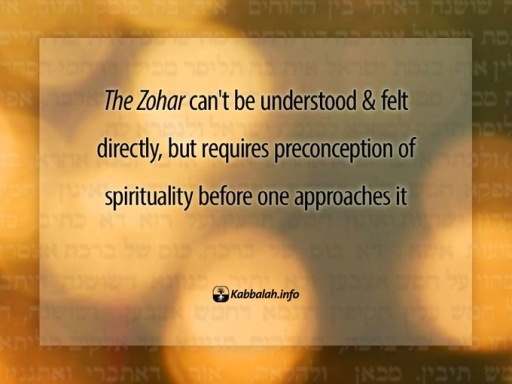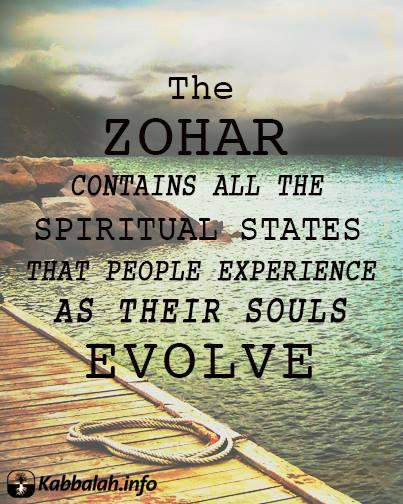3) Who Wrote The Zohar?
Who wrote The Zohar is a major area of dispute among historians, but according to all Kabbalists, and as the beginning of the book writes, The Zohar was written by Rabbi Shimon Bar Yochai (Rashbi), who lived in the 2nd and 3rd centuries CE. There are views in scholastic circles stating that The Zohar was written in the 11th century by Kabbalist Rabbi Moshe de Leon. This view was contradicted by Rabbi Moshe de Leon himself, who said that the book was written by Rashbi.
In the Kabbalistic approach, the question of why The Zohar was written is far more important than the question of who wrote The Zohar. The purpose of The Zohar is to be a guide for people to attain the origin of their souls.
This path to the origin of one’s soul consists of 125 stages. Rabbi Yehuda Ashlag writes that a Kabbalist who has passed these stages and shares the same perception as that of the book’s author, sees that its author could be none other than Rashbi.
1) What Is The Zohar?
When seeking a Zohar definition, we should understand that The Zohar is a collection of commentaries on the Torah, intended to guide people who have already achieved high spiritual degrees to the root (origin) of their souls.
The Zohar contains all the spiritual states that people experience as their souls evolve. At the end of the process, the souls achieve what Kabbalah refers to as “the end of correction,” the highest level of spiritual wholeness.
To those without spiritual attainment, The Zohar reads like a collection of allegories and legends that can be interpreted and perceived differently by each individual.
But to those with spiritual attainment, i.e. Kabbalists, The Zohar is a practical guide to inner actions that one performs in order to discover deeper, higher states of perception and sensation.

4) Why Was The Zohar Hidden For So Long?
The Zohar was kept hidden for 900 years, between the 2nd and the 11th centuries CE, since those who possessed its wisdom understood that at the time, people did not need it and would misunderstand its contents.
Only in the 16th century CE did a Kabbalist arise who explained the fundamentals of Kabbalah - The Holy Ari, Rabbi Isaac Luria (1534-1572). The Ari stated that from his time on, the wisdom of Kabbalah was ready to be opened to everyone.
Commentaries on the works of the Ari and The Zohar appeared only in the 20th century - the century that saw the fiercest outburst of human desires in history. During this period, a unique soul appeared - that of Rabbi Yehuda Ashlag (Baal HaSulam). Baal HaSulam explained the wisdom of Kabbalah in a way our generation could understand. Moreover, Baal HaSulam was the only Kabbalist in the 20th century who wrote commentaries on The Zohar and on the works of the Ari.
This does not mean that there were no great Kabbalists before him, but only that their works are not easily understood by contemporary students. Today’s popularity and high demand for Kabbalah testify to our generation’s readiness to absorb its universal message, and to comprehend the authentic texts that speak of the root of our lives and how to attain it.
5) Where Do I Find Out More About The Zohar?
The Zohar cannot be understood and felt directly, but requires preconception of spirituality, before one approaches the book. The greatest Kabbalist of our time-Rabbi Yehuda Ashlag (Baal HaSulam)-wrote introductions to The Zohar precisely to guide one’s approach to this profound book prior to studying it.
Such articles cultivate one’s spiritual qualities to perceive the higher reality. Additionally, these texts provide knowledge of how to approach certain terms, phrases, and concepts in The Zohar, to maximize its use as a guide for spiritual attainment, avoiding being lost in materialized depictions that the human mind is prone to form.
The Bnei Baruch Kabbalah Education & Research Institute provides not only these introductions, but an introductory course on them, as well as shorter articles describing concepts from The Zohar, and how to prepare for the encounter with these concepts.
We recommend that you take our
introductory course before embarking on the reading of
The Zohar, where you will get guidance on how to approach
The Zohar and other Kabbalistic texts, in order to reap the most benefit from the study.
Discovering The Zohar means discovering your inner world and your unlimited potential. Bnei Baruch wishes you success in your spiritual advancement!
 Discovering The Zohar means discovering your inner world and your unlimited potential.
Discovering The Zohar means discovering your inner world and your unlimited potential.
 [Tweet This]
[Tweet This]
2) Who Is The Zohar For?
As mentioned in answer no. 1, The Zohar was written for people who have already achieved spiritual perception. It contains the depictions of Rabbi Shimon Bar Yochai (Rashbi), who attained all 125 degrees of the spiritual ladder of degrees. Rashbi expressed the entire spiritual path and titled it Zohar (“radiance” in Hebrew).
The Zohar is built so that only those who achieve a certain spiritual level can benefit from what they read in it. Prior to studying The Zohar, one needs to study other texts that teach how to properly approach the text in The Zohar.

6) What Does "Zohar" Mean in the Bible?
“Zohar” means “radiance.” The Book of Zohar should be read solely for the purpose of evoking the upper radiance—also known as “upper light” or “reforming light”—in order to correct one’s soul.
We come to perceive the radiance contained in The Zohar the more that the light that the book gives us access to influences us. The extent to which we feel the light, which is the quality of bestowal and love dwelling in nature, is the extent to which we understand what is written in The Book of Zohar.
In addition, Kabbalist Yehuda Ashlag (Baal HaSulam) wrote four introductions to The Book of Zohar (“Preface to the Book of Zohar,” “Introduction to the Book of Zohar,” “A Speech for the Completion of the Zohar,” and “Preface to the Sulam Commentary”) which are necessary to know—or to at least have general knowledge of—in order to understand the book.
While it is possible to read The Book of Zohar, it is recommended to first study the works of Baal HaSulam, and also to reach a thorough understanding of Baal HaSulam’s four introductions to The Zohar in advance of the reading.
7) Why Was the Zohar Hidden in Past Generations?
The Zohar was hidden between the 4th and the 13th centuries CE. It was hidden despite the fact that those generations were far more spiritually mature than our generation, and deserved to study the book. However, it is important to understand that their spiritual maturity stemmed from the purity of their desires, which is the reason for these generations having no need for The Zohar to further their corrections.
8) Why Were There No Valid Commentaries to the Zohar before the 16th Century?
The 16th century was the period that saw a major upgrade in the wisdom of Kabbalah through Kabbalist Isaac Luria (the Ari). From the time The Zohar was written until the time of the Ari, no kabbalist attained the required level to clarify The Zohar and the wisdom of Kabbalah as a whole. The Ari explained the fundamentals of Kabbalah in a scientific language that suited the desires of his generation and onward, but he never wrote any commentaries on The Zohar. Rather, the 16th century saw the first ever publishing and circulation of printed versions of The Zohar.
9) Why Were There No Valid Commentaries to the Works of the Ari and the Zohar Until the 20th Century?
The 20th century was the time when Kabbalist Yehuda Ashlag (Baal HaSulam) appeared, reaching the heights of spiritual attainment, and who became the only kabbalist of his time to write commentaries both on The Zohar and on the works of the Ari, such as The Tree of Life.
Kabbalist Yehuda Ashlag received the nickname “Baal HaSulam” because of his writing and publishing the monumental “Sulam” (“Ladder”) commentary on The Zohar.
In the “Speech for the Completion of the Zohar,” Baal HaSulam described our generation as “the generation of the Messiah.” The “Messiah” is not a person, but a force of light or radiance that draws us to the revelation of the spiritual world (“Messiah” [“Moshiach” in Hebrew] from the word for “pulling” or “attracting” [“Moshech” in Hebrew]).
The reason for Baal HaSulam’s extensive commentaries, as well as his several other writings that serve to introduce people to the wisdom of Kabbalah, is due to the growing need that both he and The Zohar identified would expand in our era: the need to discover the meaning and purpose of life, which is the very need that the wisdom of Kabbalah and The Zohar responds to.
It does not mean that there were no great kabbalists before our generation. On the contrary, there were indeed great kabbalists over the centuries, but their writings were incomplete accounts of spiritual attainment. Their writings can be likened to the writings of scientists who research into a phenomenon, and generations of scientists further deepen into that research making new and different discoveries, but their research remains incomplete.
Baal HaSulam, contrary to other kabbalists, reached the full correction of his individual soul. He was thus given the permission to disclose the secrets of Kabbalah in his writings and teachings.
The fact that today we can study the wisdom of Kabbalah, read The Zohar, and enlarge the student base—in accordance with the principles that we learn from Baal HaSulam and the Ari—is testimony to the uniqueness of our generation; that our generation is the one where the need to discover the meaning and purpose of life would emerge more prominently in more and more people, up to a point where everyone will become receptive to the light that influences us through the study of these texts.

10) How to Study the Zohar
The Zohar should be read solely in order to evoke the spiritual light, which is the higher state of bestowal, love and connection that the authors of
The Zohar attained and wrote to us about in the Book. To the degree that the light will influence us, we will start perceiving
The Zohar. Also, to the extent that we will feel the light, we will also start understanding what the Book says.
In addition, Kabbalist Yehuda Ashlag (Baal HaSulam) wrote four introductions to
The Zohar, and it is necessary to at least have general knowledge about them in order to understand the Book.
While it is possible to open and read
The Zohar, in order to advance spiritually through its reading, one requires a solid grounding in the wisdom of Kabbalah, and the texts of Kabbalist Yehuda Ashlag, including his four introductions to the Book.
The Zohar is similar to the Torah and other Kabbalistic texts in that there is no need to read it from beginning to end. You can open up the book at any place, read, and receive its illumination.
Most importantly, when reading Kabbalistic texts, i.e. texts by those who attain the spiritual forces of love, bestowal and connection, our primary focus should be our intention: What do we want to attain by reading? We do not understand or feel the spiritual degrees these books write about, but by reading them with the intention to reach those degrees, then we attract them onto ourselves and bring ourselves closer to them.
11) Impact of the Zohar
The Zohar is the highest source of all Kabbalistic books. It is the most powerful source of the spiritual light of correction. Those on the spiritual path relate to it similarly to how a sick person relates to medicine.
What do we want to achieve by taking such medicine? What is our “spiritual health”? Depending on the outcome we picture to ourselves, the force contained within
The Zohar can be the elixir of life or a deadly poison.
Therefore, before opening the book, we need to calibrate ourselves and discern what we hope to receive from the reading. Using
The Zohar for spiritual progress requires us to relate to it as a certain kind of medicine. The symbol for medicine is a snake, the venom of which can be either a deadly poison or a remedy.
Therefore, in order to receive a positive impact from
The Book of Zohar, we need to approach it with a positive intention—that it will bring us closer to our higher spiritual form, more loving, giving and positively connected. Reading the Torah without such an intention makes the reading dry and lifeless, and it is even more dangerous when we read
The Zohar, which is the strongest source of the spiritual light.
It was no accident that
The Zohar was revealed only to Kabbalists, and concealed from the populace, for generations. Kabbalists are people who have attained a spiritual intention, i.e. one of love, bestowal and connection equal to the higher state that
The Book of Zohar describes. Due to their congruence with the spiritual system, they were brought to a place where they could find and use the Book.
It was concealed from other people because back then they were unable to arm themselves with the spiritual intention. That is why the impact of
The Zohar would have been harmful if it were open to all. Today, however, we can open
The Zohar with the intention that it will act on us as a potion of life, and not as a deadly poison.
The Zohar contains such an immense force that we need to be careful to open it together and with the right intention, so that we will experience its positive impact. That is why it has become revealed in our time and offers us incredible opportunities, and we wish to offer it to everyone. However, everyone approaching this book today should know that it can be an elixir of life only if approached with an intention to reach the same levels that it discusses, which are heightened states of love, bestowal and connection, in resemblance with the source of life.




 Kabbalah International
Kabbalah International